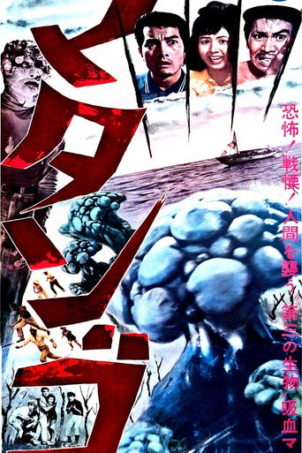 This classic of Japanese horror, from the creator of the GODZILLA flicks, was a groundbreaker in its day and remains an effective piece of work. Plus, the film has been lovingly restored for its 2005 DVD release, meaning that for the first time in over forty years we get to see MATANGO in its original widescreen glory.
This classic of Japanese horror, from the creator of the GODZILLA flicks, was a groundbreaker in its day and remains an effective piece of work. Plus, the film has been lovingly restored for its 2005 DVD release, meaning that for the first time in over forty years we get to see MATANGO in its original widescreen glory.
Believe it or not, the primitive model work and rear projection effects of MATANGO (retitled ATTACK OF THE MUSHROOM PEOPLE in the US) were considered cutting edge back in 1963, and stolen by quite a few expensive Hollywood productions of the time. Made during a boom period in the Japanese movie industry, it was an unusually serious and thoughtful effort by director Ishiro Honda, best known then and now for helming the original GODZILLA flicks (including the legendary KING KONG VS. GODZILLA, made the same year as the present film). One thing MATANGO does have in common with most of Honda’s other films—and for that matter most Japanese genre fare of the time—is the theme of nuclear-experimentation-leading-to-disaster that powers the narrative.
It was loosely based on the 1907 story “The Voice in the Night” by William Hope Hodgson, an Englishman who specialized in nautical-related horror literature, best realized in the novels THE BOATS OF THE GLENN CARRIG and THE GHOST PIRATES, as well as the immortal (though non-nautical themed) HOUSE ON THE BORDERLAND.
Interned in an insane asylum, a madman, whose face we can’t see, relates a horrific tale that occurs during a doomed sea trip. The man, a psychology professor, is sailing the open seas with his girlfriend and five other fun-loving passengers on a luxury yacht. A storm hits shortly after they set sail and strands them all on a seemingly uninhabited tropical island. After exploring this newfound terrain the group comes upon an abandoned ship moored on the other side of the island. The ship, it seems, is deserted, but coated with a weird mud-like substance. Also onboard is a giant mushroom used in a nuclear experiment that made it grow to several times its normal size.
As the days wear on the professor and his companions suffer from extreme hunger and are reduced to bickering. Several of the group experience apparent hallucinations involving freaky psychedelic creatures aboard the abandoned ship. In addition, mushrooms have begun sprouting up throughout the island, which grow at an unusually fast rate.
Inevitably one of the crewmembers, a hot chick, eats the mushrooms, which change her into…an even hotter chick, who seduces the guys on the ship into eating the mushrooms themselves. This turns them into walking ‘shroom creatures, with only one of the group, the professor, managing to resist the compulsion to partake of the ‘shrooms…or does he? He manages to flee the island on a tiny raft. He’s taken back to civilization and promptly interred in the insane asylum in which the film began—there, he turns to the camera for the first time, revealing the unmistakable signs of mushroom fungus upon his face.
Certainly MATANGO is one of, if not the, best looking of all of Ishiro Honda’s films, with bold, gaudy colors and dynamic widescreen compositions. The film for years was available only in washed-out panned and scanned prints that woefully failed to do it justice—this review applies solely to the newly released DVD by Media Blasters (not my favorite company, but I must say they’ve done a superlative job here), frankly the only home video version of MATANGO worth viewing.
The film, in direct contrast to most of Honda’s other films of the sixties, is extremely subtle and atmospheric in its approach. It has a vivid aura of claustrophobia and creeping menace, with uniformly fine performances by a young, largely inexperienced cast. Story-wise it admittedly makes little sense, but that’s part of its charm: Honda and screenwriter Takeshi Kimura wisely refrain from over-explaining the many bizarre occurrences, simply letting them unfold in the manner of the original Hodgson story, which gives the proceedings an appropriately dreamlike feel.
Many of MATANGO’S most effective moments occur when the mushroom folks of the title are only partially glimpsed at the edges of the frame and then quickly snatched away. Unfortunately, Honda can’t help but give us a full glimpse of the things in the final third, which nowadays approaches MST3K-style campiness. The goofy psychedelic effects don’t help matters, playing like something you’d expect to see during the ultra-pretentious late sixties-early seventies period of “with-it” cinema…although in all fairness, this film was released in 1963, several years before the fact.
Vital Statistics
MATANGO (THE ATTACK OF THE MUSHROOM PEOPLE)
Toho International Co., Ltd.
Director: Ishiro Honda
Producer: Tomoyuki Tanaka
Screenplay: Takeshi Kimura
(Based on the short story “The Voice in the Night” by William Hope Hodgson)
Cinematography: Hajime Koijumi
Editing: Reiko Kaneko
Cast: Akira Kubo, Kumi Mizuno, Hiroshi Koizumi, Yoshio Tsuchiya, Kenji Sahara, Hiroshi Tachikawa, Miki Yashiro
